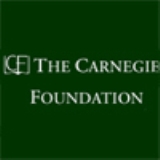
The Carnegie Foundation for the Advancement of Teaching
Encyclopedia
Founded by Andrew Carnegie
Andrew Carnegie
Andrew Carnegie was a Scottish-American industrialist, businessman, and entrepreneur who led the enormous expansion of the American steel industry in the late 19th century...
in 1905 and chartered in 1906 by an act of the United States Congress
United States Congress
The United States Congress is the bicameral legislature of the federal government of the United States, consisting of the Senate and the House of Representatives. The Congress meets in the United States Capitol in Washington, D.C....
, the Carnegie Foundation for the Advancement of Teaching is an independent policy and research center, whose primary activities of research and writing have resulted in published reports on every level of education. Nine presidents have guided the Foundation through its history, each bringing unique shape to its work.
Influential Foundation achievements include development of the Teachers Insurance and Annuity Association (TIAA), publication of the Flexner Report
Flexner Report
The Flexner Report is a book-length study of medical education in the United States and Canada, written by the professional educator Abraham Flexner and published in 1910 under the aegis of the Carnegie Foundation...
on medical education, creation of the Carnegie Unit
Carnegie Unit and Student Hour
The Carnegie Unit and the Student Hour are strictly time-based references for measuring educational attainment used by American universities and colleges; the Carnegie Unit assesses secondary school attainment, and the Student Hour, derived from the Carnegie Unit, assesses collegiate...
, founding of the Educational Testing Service
Educational Testing Service
Educational Testing Service , founded in 1947, is the world's largest private nonprofit educational testing and assessment organization...
, and establishment of the Carnegie Classification of Institutions of Higher Education. The Carnegie Foundation was a leader in the effort to provide federal aid for higher education, including Pell Grants, which assist low- and middle-income students.
Presidential highlights
Henry Pritchett secured the Congressional charter in 1906 and broadened the Foundation's mission to include work in education policy and standards. John W. Gardner became president in 1955 concurrent with his presidency of the Carnegie Corporation of New York. His focus was on balancing quality and equity. Alan Pifer, again president of both the Foundation and the Corporation, established a task force in 1967 under the leadership of Clark KerrClark Kerr
Clark Kerr was an American professor of economics and academic administrator. He was the first chancellor of the University of California, Berkeley and twelfth president of the University of California.- Early years :...
. Under Kerr's direction, the Carnegie Commission on Higher Education and the Carnegie Council on Policy Studies in Higher Education produced more than 160 policy reports, research studies and technical reports that helped define key federal policies and programs in higher education and student financial aid.
The rebirth of an independent Carnegie Foundation
With Ernest L. Boyer's appointment as president in 1979, the Carnegie Foundation for the Advancement of Teaching separated from the Carnegie CorporationCarnegie Corporation of New York
Carnegie Corporation of New York, which was established by Andrew Carnegie in 1911 "to promote the advancement and diffusion of knowledge and understanding," is one of the oldest, largest and most influential of American foundations...
, which had supported it during a period of financial problems. It became an independent institution and eventually moved to Princeton, New Jersey. During Boyer's tenure, the Foundation maintained its interest in higher education and broadened its work to recognize the interconnection of all stages in the educational experience.
Landmark policy reports, including High School: A Report on Secondary Education in America and College: The Undergraduate Experience in America, involved the Foundation in the national debate and activities around school reform and strengthening colleges and universities. Boyer's influential report, Scholarship Reconsidered: Priorities of the Professoriate, laid the groundwork for a broader definition of scholarship, which has become common parlance at universities around the United States and the world.
The move west
In the summer of 1997, with Lee S. Shulman at the helm, the Foundation relocated from Princeton, New JerseyPrinceton, New Jersey
Princeton is a community located in Mercer County, New Jersey, United States. It is best known as the location of Princeton University, which has been sited in the community since 1756...
to its current home in Stanford, California
Stanford, California
Stanford is a census-designated place in Santa Clara County, California, United States and is the home of Stanford University. The population was 13,809 at the 2010 census....
. Situated in the San Francisco Bay
San Francisco Bay
San Francisco Bay is a shallow, productive estuary through which water draining from approximately forty percent of California, flowing in the Sacramento and San Joaquin rivers from the Sierra Nevada mountains, enters the Pacific Ocean...
Area, the Foundation draws upon the rich resources of the region, including universities, philanthropic and civic institutions, and nonprofit research organizations.
Anthony S. Bryk became the ninth president of the Foundation in September 2008.
External links
- Carnegie Foundation for the Advancement of Teaching – Official site.
- Change: The Magazine of Higher Learning – Official site.
- Change: The Magazine of Higher Learning at Heldref PublicationsHeldref PublicationsHeldref Publications was the publishing division of the Helen Dwight Reid Education Foundation, a nonprofit educational organization. Professor Helen Dwight Reid, a political scientist who taught at Bryn Mawr College and the State University of New York at Buffalo, established the foundation in 1956...
.

